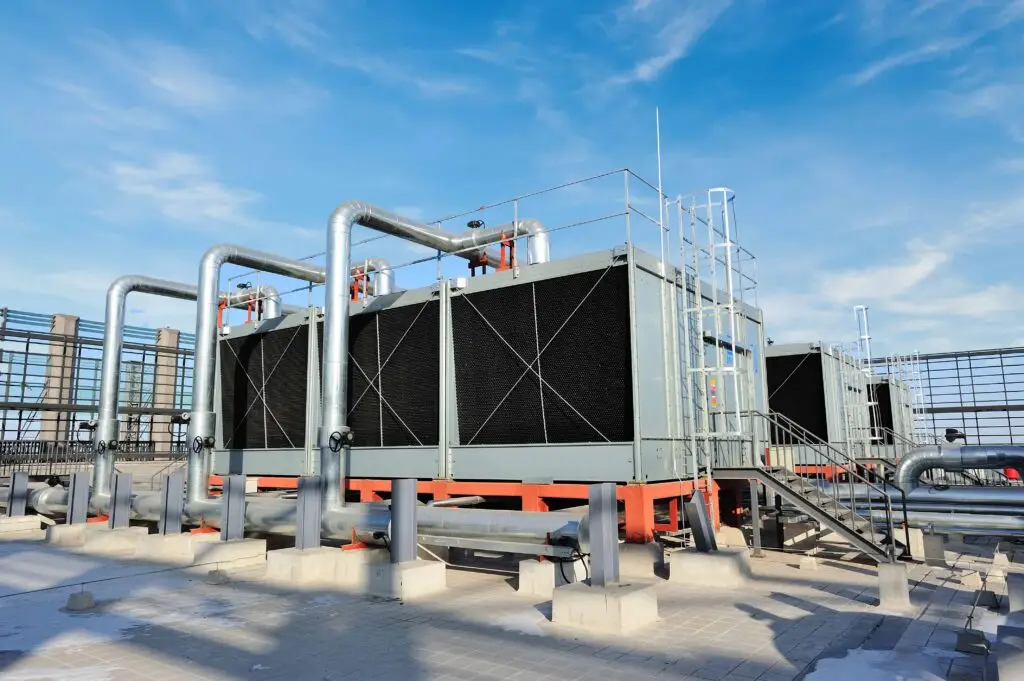Why Cooling Tower Maintenance Matters
Cooling towers are a critical part of commercial and industrial HVAC systems, playing a vital role in heat dissipation and system efficiency. Without proper maintenance, cooling towers can suffer from scaling, corrosion, water contamination, and mechanical failures, leading to higher energy costs and unexpected downtime. This guide provides key insights into best practices for cooling tower service and repair, ensuring long-term performance and reliability.
How Cooling Towers Impact HVAC Efficiency
Cooling towers help regulate heat by transferring excess heat from HVAC systems to the atmosphere through evaporation. When cooling towers are not properly maintained, they lose efficiency, leading to higher energy consumption, increased operational costs, and system strain. A well-maintained cooling tower can:
- Improve heat transfer efficiency and reduce energy waste
- Lower operational costs by preventing mechanical failures
- Extend equipment lifespan, reducing the need for expensive replacements
- Ensure compliance with safety and environmental regulations
Essential Cooling Tower Maintenance Practices
To maintain peak performance, regular mechanical service and preventive maintenance are essential. The following key areas should be part of every cooling tower maintenance plan:
Routine Inspections & Component Checks
Regular visual inspections are the first line of defense against potential issues. Key areas to monitor include:
Structural Integrity: Look for signs of physical damage, corrosion, or leaks in the tower’s framework.
Water Distribution System: Ensure nozzles and distribution basins are free from blockages to maintain even water flow.
Fill Media and Drift Eliminators: Check for debris accumulation or scaling that could impede airflow and heat exchange.
Comprehensive Cleaning Protocols
Maintaining cleanliness within the cooling tower prevents the buildup of harmful substances and enhances performance:
Basin and Sump Cleaning: Regularly remove sediment, algae, and other contaminants to prevent clogs and maintain water quality.
Fill and Drift Eliminator Maintenance: Clean these components to ensure efficient heat transfer and minimize water loss.
Surface Disinfection: Apply appropriate biocides to eliminate microbial growth, reducing health risks and maintaining system efficiency.
Optimized Water Treatment
Effective water management is vital to prevent scaling, corrosion, and biological growth:
- Chemical Treatment: Utilize corrosion inhibitors, scale dispersants, and biocides to maintain water chemistry within desired parameters.
- Blowdown Management: Implement controlled water discharge to remove dissolved solids, balancing water conservation with system health.
- Filtration Systems: Incorporate advanced filtration solutions, such as microsand filtration, to enhance water clarity and reduce biofouling.
Mechanical Component Maintenance
Ensuring the mechanical parts of the cooling tower are in optimal condition prevents unexpected failures:
- Fan and Motor Care: Inspect and lubricate bearings, check alignment, and balance fan blades to maintain proper airflow and reduce energy consumption.
- Pump and Valve Checks: Regularly assess for leaks, wear, and proper operation to ensure efficient water circulation.
- Control System Calibration: Verify that sensors and control panels are functioning correctly to optimize system performance.
Seasonal Shutdown and Startup Procedures
Properly managing periods of inactivity can extend the lifespan of the cooling tower:
- Shutdown Protocols: Thoroughly clean and drain the system, inspect for damage, and perform necessary repairs before extended downtime.
- Startup Checks: Before resuming operation, conduct comprehensive inspections, refill with treated water, and test all mechanical and control systems.
Documentation and Continuous Improvement
Keeping detailed records aids in tracking maintenance activities and identifying areas for enhancement:
- Maintenance Logs: Document all inspections, cleanings, repairs, and modifications performed on the cooling tower.
- Performance Metrics: Monitor parameters such as temperature differentials, energy consumption, and water usage to assess efficiency.
- Review and Adaptation: Regularly evaluate maintenance strategies and update protocols based on performance data and emerging best practices.
By adopting this structured maintenance strategy, facility managers can ensure their cooling towers operate efficiently, safely, and sustainably, thereby supporting the overall performance of their HVAC systems.
Common Cooling Tower Issues & How to Address Them
To maintain peak performance, regular mechanical service and preventive maintenance are essential. The following key areas should be part of every cooling tower maintenance plan:
1. Scaling & Mineral Deposits
- Caused by improper water treatment; leads to reduced cooling capacity
2. Optimizing Water Treatment for Maximum Efficiency
- Corrosion and physical wear can lead to water loss and inefficiency
3. Reduced Airflow & Fan Malfunction
- Dirty or broken fan blades reduce heat dissipation efficiency
4. Reduced Airflow & Fan Malfunction
- Misaligned motors and worn-out bearings can cause operational disruptions
Avoid Costly Repairs and Maximize Energy Savings
Taking a proactive approach to cooling tower maintenance is more than just preventing breakdowns—it’s a smart strategy that boosts performance and cuts costs.
In busy commercial and industrial settings, routine maintenance is key. It helps:
- Keep your cooling tower running at peak performance.
- Extend the life of important system components.
- Prevent costly repairs that can disrupt your operations and hurt your budget.
Regular inspections, cleanings, and mechanical tune-ups reduce the risk of unplanned downtime, which can lead to delayed work, missed deadlines, and expensive emergency fixes. When properly maintained, your cooling tower runs more efficiently, providing real energy savings and reducing your environmental impact.
Routine maintenance also improves airflow, water quality, and heat transfer, making the workplace safer for both your maintenance team and building occupants. Compared to reactive maintenance, this preventive approach is far more cost-effective, especially if you’re managing large-scale HVAC systems or working in high-demand industries.

